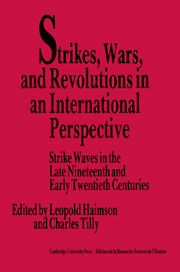 Strikes, Wars, and Revolutions in an International Perspective
Strikes, Wars, and Revolutions in an International Perspective Book contents
- Frontmatter
- Contents
- List of contributors
- Preface
- Part I Introductions
- Part II Models and realities
- 3 Introduction
- 4 Changing forms of labor conflict: secular development or strike waves?
- 5 Strikes and power in Britain, 1870–1920
- 6 Two strike waves in Imperial Russia, 1905–1907, 1912–1914
- 7 Strikers in revolution: Russia, 1917
- 8 Strikes in Imperial Russia, 1895–1913: a quantitative analysis
- 9 Labor conflicts in Italy before the rise of fascism, 1881–1923: a quantitative analysis
- 10 Strikes and politics in the United States, 1900–1919
- Part III Workers in metal-processing enterprises in comparative perspective
- Part IV The effects of short-term variation
- Part V Conclusion
6 - Two strike waves in Imperial Russia, 1905–1907, 1912–1914
Published online by Cambridge University Press: 25 March 2010
- Frontmatter
- Contents
- List of contributors
- Preface
- Part I Introductions
- Part II Models and realities
- 3 Introduction
- 4 Changing forms of labor conflict: secular development or strike waves?
- 5 Strikes and power in Britain, 1870–1920
- 6 Two strike waves in Imperial Russia, 1905–1907, 1912–1914
- 7 Strikers in revolution: Russia, 1917
- 8 Strikes in Imperial Russia, 1895–1913: a quantitative analysis
- 9 Labor conflicts in Italy before the rise of fascism, 1881–1923: a quantitative analysis
- 10 Strikes and politics in the United States, 1900–1919
- Part III Workers in metal-processing enterprises in comparative perspective
- Part IV The effects of short-term variation
- Part V Conclusion
Summary
Introduction
The quantitative analyses of labor unrest that we shall seek to summarize were originally conceived for the purposes of a broader study of the evolution of Russian society and politics on the eve of the First World War. In the perspective of this larger study, our original aim was to distinguish as precisely as possible the characteristics of the wave of labor unrest that broke out in April 1912, in immediate response to the Lena gold-field massacre, and to situate the character and scope that this labor unrest assumed up to the outbreak of the war in the context of the political and social crisis that built up during these years in the confrontation between the State power (and the landed nobility on which its political support increasingly rested) and the upper and lower social strata of urban, commercial, and industrial Russia. From its very inception, however, our analysis also involved an effort to compare the build-up of this prewar crisis with the processes that had culminated in the Revolution of 1905. Indeed, we were struck from the very outset by two major features that appeared to distinguish the character and dynamics of the political and social conflicts that the Russian body politic experienced during these prewar years from those that had surfaced in 1905–7.
- Type
- Chapter
- Information
- Strikes, Wars, and Revolutions in an International PerspectiveStrike Waves in the Late Nineteenth and Early Twentieth Centuries, pp. 101 - 166Publisher: Cambridge University PressPrint publication year: 1989
- 3
- Cited by


